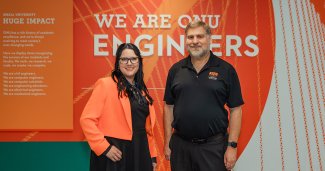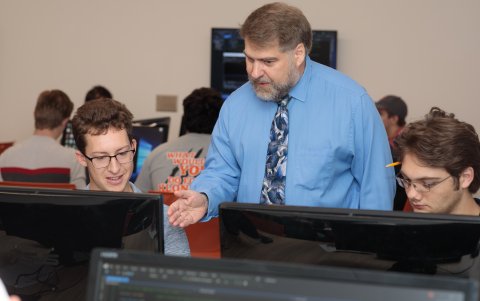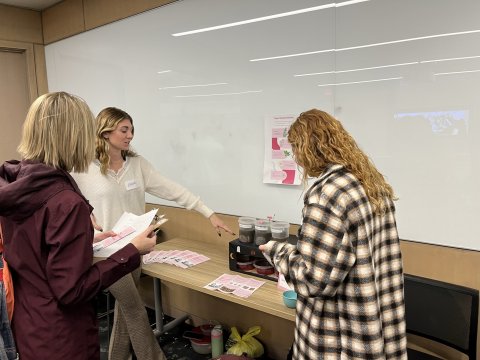
Two Ohio Northern faculty members were recently named 2024 Engineering Unleashed Fellows. John Estell, professor of computer engineering and computer science, and Lauren Logan, associate professor of civil and environmental engineering, are among 31 engineering faculty from 27 institutions across the United States to receive this honor.
The awards are through the Kern Entrepreneurial Engineering Network (KEEN), a partnership of 66 undergraduate engineering programs, which focuses on developing an entrepreneurial mindset in undergraduate engineering students.
Estell and Logan were chosen based on innovative teaching projects which they will be able to continue and enhance with the support of the fellowship.
Studying a “smart toaster”
Estell’s project, which started last fall, involved teams of students in his Project Development class who analyzed a failed Kickstarter project involving a “smart toaster.” The teams, made up of students from different engineering and computer science majors, worked together to do a SWOT analysis of the project. (A SWOT analysis is a strategic planning tool, which stands for strengths, weaknesses, opportunities, and threats.)
Logan’s project involved 32 students in her Geotechnical Engineering class who created museum exhibits based on topics they were studying. Students worked in teams of two or three to create exhibits, which were later shared with the campus community.
Estell’s Project Development course is designed to prepare junior students for their senior design experience.
“Part of what I’ve been trying to do in this course is to provide students not only with the skills to succeed in the upcoming class, but in the next 40 or 50 years of their careers where they are going to be working in groups,” he said.
A key part of the effort is the concept of psychological safety, which helps students in teams prepare to talk about their weaknesses as well as their strengths.
Psychological safety involves a variety of factors—being willing to admit when they need help, or share that they don’t know something, or admit that certain areas are not their strength.
“I think that’s very hard to say in a group,” said Estell.
The failed Kickstarter project, a “smart toaster,” raised six figures in support, but didn’t succeed. The toaster could print designs or information on toast, looking like a Georges Seurat pointillist painting, Estell explained, except the dots were in brown scale rather than in color.
Each team included students from three majors – electrical engineering, computer engineering, and computer science.
The electrical engineering majors focused on the microfilament heating elements in the toaster that were used to create the design; the computer engineers focused on the communication between the app and the microfilaments; and the computer science students focused on the app design.
“So collectively, they could pull it off,” said Estell.
The class researched technical media articles about the toaster project as well as product comments and updates on Kickstarter. “They could get a good indication of why it failed.” They’re learning from someone else’s failure and figuring out how to do things better, he added.
Designing a museum exhibit
In a pilot project last year, Lauren Logan’s class of 32 students took on the challenge of designing a museum exhibit, based on what they were learning in their geotechnical engineering course. The focus was on soil mechanics.
Working in teams of two or three on the exhibit gave students a chance to present the material in a new and exciting way, rather than the usual approach of just writing a report or doing a presentation, Logan said. “It was an interactive and creative experience.”
Students developed exhibits on soil-related topics such as landfills, cemeteries, and athletic fields. A one-day public exhibition gave students and faculty from all over campus a chance to see the exhibits and talk to students about them.
“Allowing students to choose their own topic really emphasizes autonomy,” Logan said.
“It helps students understand the material and feel more motivated. They got to be creative and it was fun.”
Both faculty members plan to use the award to enhance the courses this fall. Estell he said he would like to embed more of the value of psychological safety into the preparation and course. “I want to get student to try to understand you can have 1,000 failures to one success.”
Like Estell, Logan plans to use the support from the KEEN award to enhance her course this fall, making the museum exhibit the big project for the semester. She also plans to incorporate a field trip to a museum, giving students a chance to talk to museum exhibit designers. She’s planning to set up another public event featuring the museum exhibits in mid-November.
She also wants to do more research on how to assess this type of very creative interdisciplinary project so professors at other institutions can take the ideas and apply them to their classes.
The designation as an Engineering Unleashed Fellow recognizes leadership in undergraduate engineering education, according to a news release from the organization. The goal is to support innovative education practices aimed at preparing engineering graduates to identify opportunities for creating positive economic, societal, and personal value throughout their lives.
“We’re not trying to make students into entrepreneurs,” said Estell, but trying to give them an entrepreneurial mindset. Since most engineering projects involve working with clients from other fields, teamwork and communication skills are valuable, he explained.
“We often think of engineering as being math and science heavy,” Logan added, “but it’s really communication heavy as well. Engineers need to be able to communicate effectively with a broad range of individuals.”
“If you think of entrepreneurship as a platform or jumping off point for engineers to create value for society, to create value with the things that they do, and find the connections across disciplines, those are the things this project also does,” she said.

